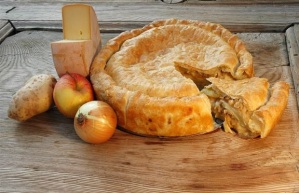 This traditional Swiss recipe got its dubious name most likely during the cholera epidemics of the early 19th century; unwilling to leave the house, they used what they had on hand, packing it into a pie and baking it. An educated guess is that, especially up in the Alps where technology was slow to come and even slower to be accepted, people were baking these either in their stone or clay bread ovens. The apples add a nice contrast to the leeks and ham, and a good cheese makes all the difference in the world! Raclette cheese is recommended for the reason that it’s quite a creamy melting cheese, but any good-quality cheese will work as well – Appenzeller, Gruyere, Emmentaler, etc.
This traditional Swiss recipe got its dubious name most likely during the cholera epidemics of the early 19th century; unwilling to leave the house, they used what they had on hand, packing it into a pie and baking it. An educated guess is that, especially up in the Alps where technology was slow to come and even slower to be accepted, people were baking these either in their stone or clay bread ovens. The apples add a nice contrast to the leeks and ham, and a good cheese makes all the difference in the world! Raclette cheese is recommended for the reason that it’s quite a creamy melting cheese, but any good-quality cheese will work as well – Appenzeller, Gruyere, Emmentaler, etc.
Swiss Cholera
1 large onion, finely diced
300 gr. Leeks (3-4 stalks), halved lengthwise and ringed
60 gr. Ham, finely chopped
Nutmeg, salt and pepper to taste
250 gr. (6-8 med.) potatoes, boiled, chopped
2 apples, peeled, cored and chopped
150 Raclette cheese, or any good cheese, grated or diced
butter and flour for the baking form
500 gr. Pie crust dough (enough for a bottom and top crust)
1 egg yolk for brushing the top dough
Traditional Method:
Preheat oven to 200°C (400°F) Prepare the vegetables. Saute the ham, adding spices to taste, then add the onion and leek, then add the chopped potatoes and apples; stir well, remove from heat. Just before pouring the mixture into the prepared bottom crust, mix the grated cheese into the pan well.
Butter and flour your chosen baking form (round, or casserole), and then lay the bottom crust in. Pour in the mixture, spreading out and topping with the top crust. Pinch the edges together, slice away any extra dough, and puncture the top dough with a knife or fork to allow steam to escape. Brush with the egg yolk, and bake for ~35-45 minutes.
My Method:
Preheat the oven. Instead of sauteeing the vegetables before baking, I prepare the vegetables as described in the ingredients list, then toss them together with the grated cheese and spices before pouring it all into the prepared bottom crust. I add a wee bit of milk, but it’s not really necessary. Top with the top crust, pinch it together and trim away the extra dough, then bake as above. In the boiling of the potatoes, I also added a few carrots to add a bit of colour; I boiled them with the potatoes, and chopped them both to large bite-sized bits once they were cool enough to handle.
En Guete!
Prep: 30 minutes / Bake: 45 minutes / Total: 75 minutes



